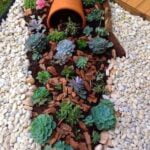Introduction
Bone meal is a finely ground powder made from animal bones. It’s an organic fertilizer that’s been used for centuries in vegetable gardening. The bone meal is high in phosphorus, zinc and other essential nutrients, making it a great addition to soil for tomatoes, squash and other plants. The fine powder also helps to reduce soil compaction and can increase drainage, allowing the soil to better absorb water. Additionally, it breaks down slowly over time, providing a constant source of nutrients to the plant while promoting vigorous root growth.
Benefits of Using Bone Meal as a Fertilizer For Vegetable Gardens
Bone meal is a high-phosphorus fertilizer that can be beneficial for vegetable gardens. Phosphorus is essential for healthy nutrient absorption by plants, which helps them grow and produce healthy fruit. Bone meal also contains calcium, which helps promote strong root systems and cell walls in plants. Not only can bone meal provide vital nutrients to your garden, it is also an organic fertilizer that improves soil quality. The nitrogen content of bone meal will help the soil retain moisture, making it easier for your vegetables to soak up the water they need. Furthermore, microbial activity in your garden increases with the addition of bone meal due to its beneficial microorganism content; this encourages efficient nutrient uptake by vegetables and other plants. Ultimately, using bone meal for vegetable gardening can leave you with stronger, healthier plants that are more resistant to pests and disease.
How to Select the Right Type of Bone Meal for Your Vegetable Garden
Choosing the right type of bone meal for your vegetable garden is essential to ensuring its success. This is because bone meal is an important fertilizer that supplies nitrogen, calcium, and phosphorus to your vegetables. All three play key roles in crop growth and development.
When selecting bone meal, you should first look at the analysis on the bag’s label. Bone meal can come with various ratios of nitrogen, calcium, and phosphorus, so you want to understand which ratio best suits your needs. A formulation with a higher amount of nitrogen will help give your plants the energy they need for vigorous growth and abundant fruit production. If you’re looking for more calcium or phosphorus for better root strength and disease resistance, then a higher ratio of those two elements would be suitable. If you’re focused on improving soil structure and fertility, then a 3-1-2 blend from a high quality source should do just fine.
Another thing to consider when selecting bone meal is organic certification. Organic gardens use only natural ingredients that are free from synthetic chemicals or other harmful components. There are several brands out there that offer organic products so make sure to read up on the product details before buying them. You can also review customer reviews online to get an idea of the product’s performance in real life applications. Finally, pay attention to any special instructions or precautions on the label in order to obtain optimal results from your application!
Best Practices for Adding Bone Meal to the Vegetable Garden Soil
Adding bone meal to the vegetable garden soil is an effective way to increase the amount of essential nutrients available for growth. To ensure the best results when incorporating bone meal into a vegetable garden, there are certain best practices which should be followed.
First, test the soil’s levels of phosphorus prior to any application of bone meal. If the soil already has sufficient levels of phosphorus, then applying bone meal could be detrimental. Always follow package instructions regarding how much and how often to apply the fertilizer.
When preparing beds for planting, add a thin layer of compost before laying down a generous sprinkling of bone meal. Do not just sprinkle the bones on top of existing soil as it will not interact as well with all layers of earth beneath and promote good root stability in plants due to their high nitrogen content.
If planning on container gardening, add two tablespoons per gallon container size for optimal absorption and incorporation into potting mix- never use directly in container gardens without being properly blended first. Lastly, lighten up on fertilizing in spring until mid-summer when plants begin actively producing fruits and vegetables; this will prevent overfertilization – something that can stunt or prevent growth altogether!
Different Ways to Incorporate Bone Meal into Your Vegetable Garden
Adding bone meal for vegetable gardening is an easy yet effective way to incorporate essential nutrients into your soil. Bone meal is a natural and slow-release fertilizer that provides plants with phosphorus, nitrogen, and other trace minerals. Bone meal can be added to the soil before planting or directly to existing plants. Here are some of the ways you can incorporate bone meal into your vegetable garden:
1. Incorporate bone meal when planting seeds or bulbs – Simply mix in 2-3 tablespoons of bone meal per square foot of soil before planting. This helps create healthy root systems that drive strong plant development throughout the season.
2. Fertilize existing plants directly with bone meal – To help enhance growth, sprinkle a handful of bonemeal around each existing plant every few months or so. This helps create more efficient nutrient uptake for faster growth and more abundant yields than traditional methods alone provide.
3. Mix asphalt emulsions in ratio with water and include bone meal – By using this combination, you will achieve maximum bond strength between soil particles which helps make nutrient absorption easier for stronger plants overall.
4. Make a fertilizer tea by soaking the bone meal in warm water overnight – Doing this makes the nutrients more readily available to absorb through the root system and offers better assimilation into the surrounding soil. Use this ‘tea’ by sprinkling it around newly planted seedlings or established plants to give them a boost for better performance over time!
How to Divide Bone Meal Properly Throughout Your Vegetable Garden
To properly divide bone meal throughout your vegetable garden, the first step is to determine how much of the material you need. This can be done by measuring the size of your garden and calculating the total area. An easy way to do this is by multiplying the length and width of your garden site together.
Once you have determined the amount of bone meal needed for your garden, it is important to distribute it evenly within the planting areas. Depending on what type of plants you are growing in your vegetable garden, you may need a larger dose of bone meal in some areas than others. To avoid over-fertilizing or burning any area, use a slow release fertilizer such as bone meal that will regulate its release over time.
It is important to make sure that when applyingbone meal around each plant, there should be one to two tablespoons per square foot of soil or composted material distributed evenly over the entire site. If possible, mix it into the soil upon application as this will help with absorption by givingthe roots direct access to nutrients. As part of regular maintenance for your vegetable garden’s fertility health, add moreBone Meal every 6-12 months depending on soil fertility at that time.
Advantages of Using Bone Meal in Vegetable Gardens
Bone meal is a natural fertilizer option for vegetable gardens. It is made from ground up animal bones and provides an abundance of nutrients beneficial to vegetables, including phosphorus, calcium and nitrogen. Adding bone meal to the soil helps support the plants’ root development, which leads to larger vegetables and better yields. The minerals it contains also help regulate a plant’s pH levels and increase water absorption. Bone meal also works as a soil amendment that enriches and aerates the soil, helping perk up compacted soils as it breaks down in the presence of water.
In terms of advantages of using bone meal on vegetable gardens, rest assured that increased nutrient uptake will result in bigger buds and more plentiful blooms. The additional nutrients provided by bone meal bolster plant growth by increasing access to essential elements crucial to healthful plant production including nitrogen for leafy green growth; potassium for strong root development; sulfur for antibacterial properties; and phosphorus for overall tissue maintenance. Bone meal works especially well when added with other organic components such as compost or manure to create a nutrient-rich substrate perfect for lush vegetable gardens. Furthermore, its slow release into the soil allows busy gardeners time away while their garden flourishes with the energy derived from this powerful organic amendment.
Common Questions and Answers About Bone Meal and Vegetable Gardening
Q: What is Bone Meal?
A: Bone meal is an organic fertilizer that is made up of ground up animal bones. It contains high levels of phosphorus and calcium, essential minerals for strong and healthy vegetable growth.
Q: How do I apply the bone meal to my vegetable garden?
A: The ideal way to apply bone meal is to mix it into your soil prior to planting seeds or seedlings. If you choose to top-dress the soil with bone meal after plants have been established, lightly work it in so there won’t be any stem contact or burn your plants. Additionally, avoid using too much bone meal as it can lead to nutrient imbalances in your soil. A general rule of thumb when applying bone meal is ¼ cup per 10 square foot area of your garden.
Conclusion
Bone meal is a great supplement for any vegetable garden. It provides essential nutrients such as phosphorus, nitrogen, and calcium that help your garden’s overall health, leading to healthier and more productive plants. By applying bone meal directly to the soil or incorporating it in a fertilizer mix, you can ensure that your vegetable gardens have all the nutrients they need throughout the growing season. In addition, bone meal helps promote an environment of beneficial microorganisms that improve soil fertility and encourage plant growth. With these benefits, bone meal is an important tool for keeping your vegetable garden healthy for years to come.

Welcome to my gardening blog! I am passionate about plants and enjoy sharing my knowledge and experiences with others. In this blog, I will write about everything related to gardening, from tips on how to get started to updates on my own garden projects.





